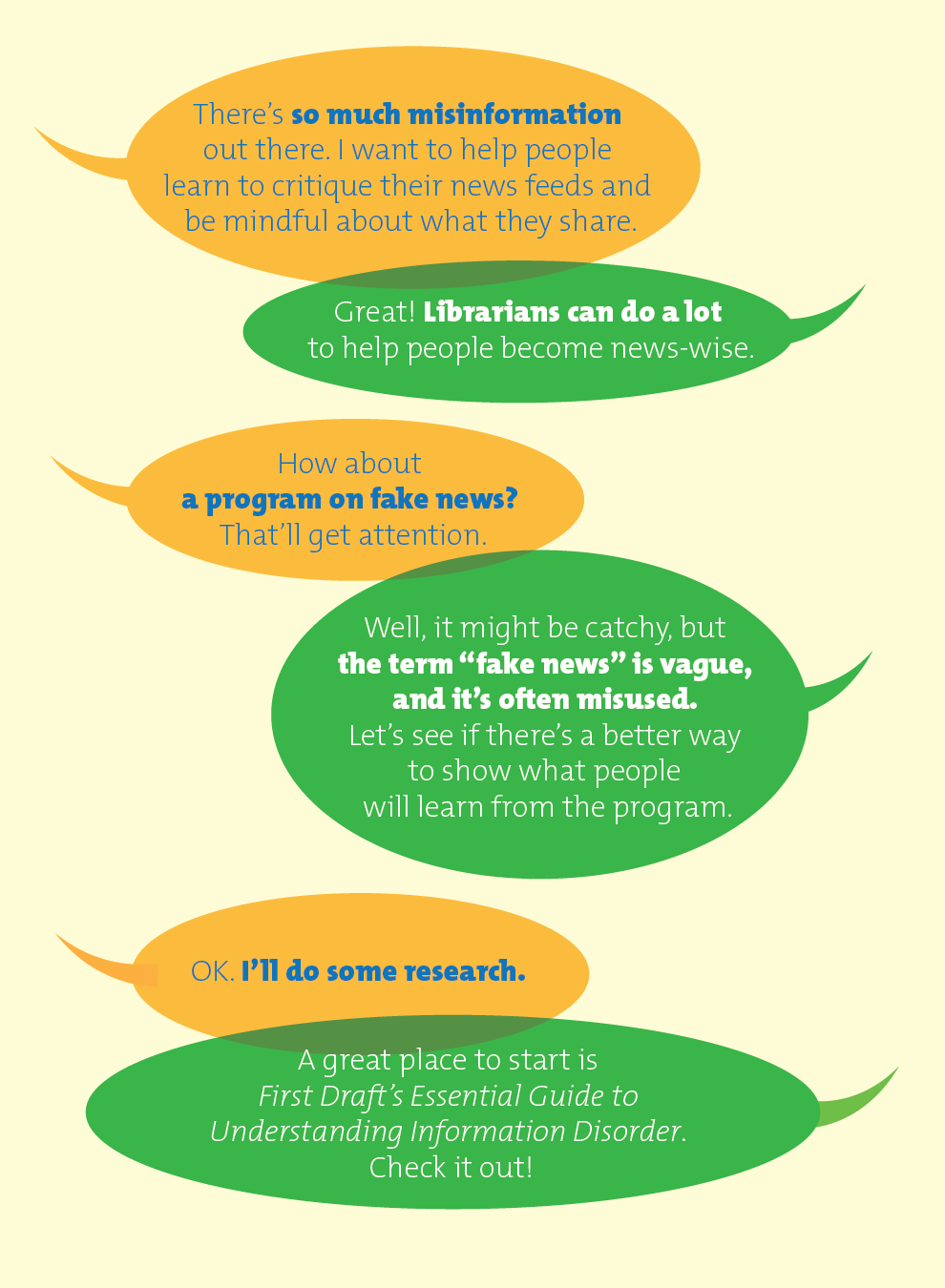Words matter when we talk about the nature and impact of misinformation.
Every time I see a library program spotlighting “fake news,” I cringe.
Don’t get me wrong. These efforts are crucial, and we need even more. Librarians care deeply about information quality, and we know the value of media literacy. We’re vigilant about the content of our feeds and we can help others learn to filter theirs, separating fact from fiction. But we don’t need to use “fake news” as our framework.
Questionable information takes many forms, and the language we use to talk about it matters. The term “fake news” isn’t new, but it’s problematic. At best, focusing on “fake news” oversimplifies a complex problem; at worst, the practice supplies ammunition to a term that’s become dangerously weaponized. There are better options.
Word problems
The terms that define the dark side of information are evolving. For many, “fake news” has become a catchall that describes anything from honest mistakes to intentional deceptions. Dictionary.com, which added the term in 2017, defines it as “false news stories, often of a sensational nature, created to be widely shared or distributed for the purpose of generating revenue, or promoting or discrediting a public figure, political movement, company, etc.”
Anyone who’s stood in line with the grocery store tabloids knows that sensationalizing false stories to generate revenue is not a rare business model.
But the words become more ominous when “fake news” is deliberately used to discredit an individual or organization. Or when political leaders apply “fake news” labels to reporting, however accurate, in attempts to undermine the journalism we depend on to stay informed. This is not just happening in the United States. The “fake news” epithet has become a weapon in an international information war.
Accusations of “fake news” often segue into claims that journalists are “the enemy of the people”—verbal lobs that impact careers and lives. In 2019 Reporters Without Borders downgraded the United States to #48 on its World Press Freedom Index, noting that U.S. reporters are being subjected to more death threats than ever before. Ranked just below Romania, America is now categorized as a “problematic” place for journalists to work.
Words matter. “The words we choose to describe media manipulation can lead to assumptions about how information spreads, who spreads it, and who receives it,” writes Caroline Jack in Lexicon of Lies: Terms for Problematic Information. “These assumptions can shape what kinds of interventions or solutions seem desirable, appropriate, or even possible.”
Toward solutions
As information professionals, we can help shape solutions.
We can learn more. Researchers have developed detailed taxonomies and glossaries to map and define forms of falsity based on the content’s characteristics and creator’s intent. It’s important to be clear, for example, about the difference between misinformation, inaccurate information that is not intended to harm, and disinformation, false information that is intentionally harmful. Good vocabulary builders include Jack’s Lexicon of Lies and Claire Wardle’s Information Disorder: The Definitional Toolbox.
We can share what we learn, starting with our own teams. We can try out activities in Data & Society’s Lexicon of Lies: Teaching Resources and talk about the language of information disorder. We can make informed word choices, thinking twice before we headline “fake news” in a program or research guide, perhaps substituting a more specific title or introducing a broader term like “information pollution.”
When the Skokie [Illinois] Public Library produced a series of media literacy workshops in 2018—including “Mindful Media Consumption,” “How Do You Get the News?,” “What Makes It News?” and “How Do You Check Facts?”—librarian Mimosa Shah thought carefully about verbiage. “I labeled the series ‘Get a Grip’ because I wanted to reduce the anxiety felt around current events,” she explains. “I wanted to focus on what can we do as consumers of news media, what can we exercise when we scroll through our feeds, what is our choice when we look at something and think about it deeply, and how do we apply that to the work that we do in our lives.”
Clarifying the conversation
We don’t have to fear “fake news.” But when the term enters our discussions, we can explore nuances. We can look for ways to create context, to consider the history and impact of the term, to examine its use and misuse. We can help bring clarity to the conversation. Ω
Resources
“The dictionary is adding an entry for ‘fake news,’” by Katy Steinmetz for TIME, September 27, 2017.
First Draft’s essential guide to understanding information disorder, by Claire Wardle, October 2019.
“How we know journalism is good for democracy,” by Josh Stearns for Office of Citizen, June 26, 2018.
“Information disorder: The definitional toolbox,” from First Draft, July 6, 2018. Introduces a three-part toolkit by Claire Wardle:
- “Information disorder, part 1: The essential glossary”
- “Information disorder, part 2: Mapping the landscape”
- “Information disorder, part 3: Useful graphics”
Lexicon of lies: Terms for problematic information from Data & Society, 2017. Introduces a full report and set of teaching resources such as “activities, exercises, and writing prompts are suggestions for incorporating the Lexicon into educational settings.”
- Full report (20-page PDF): Lexicon of lies: Terms for problematic information, by Caroline Jack, 2017.
- Teaching resources (4-page PDF): Lexicon of lies: Teaching resources, by Caroline Jack and Monica Bulger, 2017.
“The U.S. now ranks as a ‘problematic’ place for journalists,” by Sasha Ingber for NPR, April 18, 2019.
Questionable information takes many forms, and the language we use to talk about it matters.
“The words we choose to describe media manipulation can lead to assumptions about how information spreads, who spreads it, and who receives it. These assumptions can shape what kinds of interventions or solutions seem desirable, appropriate, or even possible.”
—Caroline Jack
We can explore nuances. We can look for ways to create context, to consider the history and impact of the term, to examine its use and misuse. We can help bring clarity to the conversation.


Comments are closed.